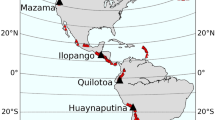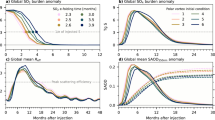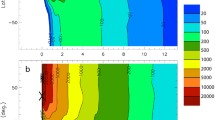Abstract
Volcanic gases such as SO2, H2S, HCl and COS emitted during explosive eruptions significantly affect atmospheric chemistry and therefore the Earth's climate. We have evaluated the dependence of volcanic gas emission into the atmosphere on altitude, latitude, and tectonic setting of volcanoes and on the season in which eruptions occurred. These parameters markedly influence final stratospheric gas loading. The latitudes and altitudes of 360 active volcanoes were compared to the height of the tropopause to calculate the potential quantity of volcanic gases injected into the stratosphere. We calculated a possible stratospheric gas loading based on different volcanic plume heights (6, 10, and 15 km) generated by moderate-scale explosive eruptions to show the importance of the actual plume height and volcano location. At a plume height of 15 km for moderate-scale explosive eruptions, a volcano at sea level can cause stratospheric gas loading because the maximum distance to the tropopause is 15–16 km in the equatorial region (0–30°). Eruptions in the tropics have to be more powerful to inject gas into the stratosphere than eruptions at high latitudes because the tropopause rises from ca. 9–11 km at the poles to 15–16 km in the equatorial region (0–30°N and S). The equatorial region is important for stratospheric gas injection because it is the area with the highest frequency of eruptions. Gas injected into the stratosphere in equatorial areas may spread globally into both hemispheres.








Similar content being viewed by others
References
Andres RJ, Kasgnoc AD (1997) A time-averaged inventory of subaerial volcanic sulfur emissions. J Geophys Res 103:25251–25261
Bluth GJS, Rose WI, Sprod IE, Krueger AJ (1997) Stratospheric loading of sulfur from explosive volcanic eruptions. J Geol 105:671–683
Carr MJ (1984) Symmetrical and segmented variation of physical and geochemical characteristics of the Central American front. J Volcanol Geotherm Res 20:231–252
de Brito Mendes V (1998) Modeling the neutral-atmosphere propagation delay in radiometric space techniques. PhD Thesis, University of New Brunswick, USA
Halmer MM, Schmincke H-U, Graf H-F (2002) The annual volcanic gas input into the atmosphere, in particular into the stratosphere: a global data set for the last 100 years. J Volcanol Geotherm Res 115:511–528
Holton JR, Haynes PH, McIntyre, Douglass AR, Rood RB, Pfister L (1995) Stratosphere-troposphere exchange. Rev Geophys 33:403–439
McCormick MP, Thomason LW, Trepte CR (1995) Atmospheric effects of the Mt Pinatubo eruption. Nature 373:399–404
Simkin T (1993) Terrestrial volcanism in space and time. Annu Rev Earth Planet Sci 21:427–452
Simkin T, Siebert L (1994) Volcanoes of the world: a regional directory, gazeteer, and chronology of volcanism during the last 10,000 years. Geoscience Press, Tucson, pp 1–349
Stoiber RE, Williams SN, Huebert B (1987) Annual contribution of sulfur dioxide to the atmosphere by volcanoes. J Volcanol Geotherm Res 33:1–8
Takada A (1999) Variations in magma supply and magma partitioning: the role of tectonic settings. J Volcanol Geotherm Res 93:93–110
Wong S, Wang W-C (2000) Interhemispheric asymmetry in the seasonal variation of the zonal mean tropopause. J Geophys Res 105:26,645–26,659
Yue GK, Poole LR, McCormick MP, Veiga RE, Wang PH, Rizi V, Masci F, D'Altorio A, Visconzi G (1995) Comparing simultaneous stratospheric aerosol and ozone lidar measurements with SAGE II data after the Mount Pinatubo eruption. Geophys Res Lett 22:1881–1884
Acknowledgements
This work was supported by the German Ministry of Research and Technology, BMBF (AFS, Aerosol-Forschungs-Schwerpunkt), project 07 AF 100 "Characterization of aerosol sources: global balancing of volcanic stratospheric aerosol precursors dependence on the tectonic macro environment and relevance for the ozone chemistry and global climate". Some support by the Deutsche Forschungsgesellschaft is also acknowledged (SFB 574). We thank Anette K. Mortensen and Christiane Textor for a critical review of an earlier version of the manuscript. We also thank D. Pyle and W. Rose for their most helpful comments. This study fulfills part of the Ph.D. requirements of M.M. Halmer.
Author information
Authors and Affiliations
Corresponding author
Additional information
Editorial responsibility: T.H. Druitt
Rights and permissions
About this article
Cite this article
Halmer, M.M., Schmincke, HU. The impact of moderate-scale explosive eruptions on stratospheric gas injections. Bull Volcanol 65, 433–440 (2003). https://doi.org/10.1007/s00445-002-0270-x
Received:
Accepted:
Published:
Issue Date:
DOI: https://doi.org/10.1007/s00445-002-0270-x




